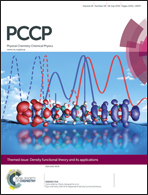Polarizability of fullerene [2+2]-dimers: a DFT study
Abstract
Currently, the exaltation of polarizability of (C60)2 dimers has been predicted with DFT-methods (D. Sh. Sabirov, RSC Adv., 2013, 3(42), 19430). It consists of an increase in the polarizability when two C60 molecules are united, forming a [2+2]-dimer. In the present work, we point attention to the bicage structures of the other fullerenes, which are promising compounds for nano-applications. We have performed the first density-functional theory study on the polarizability of fullerene [2+2]-dimers (Cn)2 (n = 20, 24, 30, 36, 50, and 70) and shown that the exaltation of polarizability is typical for all the members of the fullerenes family.
![Graphical abstract: Polarizability of fullerene [2+2]-dimers: a DFT study](/en/Image/Get?imageInfo.ImageType=GA&imageInfo.ImageIdentifier.ManuscriptID=C3CP55528C&imageInfo.ImageIdentifier.Year=2014)
- This article is part of the themed collection: Density functional theory and its applications

 Please wait while we load your content...
Please wait while we load your content...